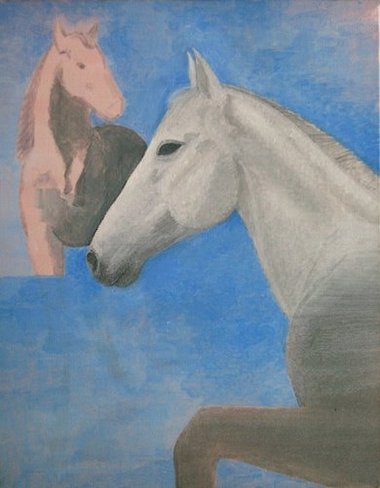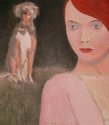John Hurrell – 31 July, 2009
The real surprise in this show is the single canvas work of a couple of horses, with one delicately rendered as if it could be part of a fresco.
Harrison’s nine works here are characteristically small and intimate, yet varied in tonal mood. Most are works on paper, using diluted acrylic with a little pencil, though there is one work on canvas. There is not so much positive/negative interaction of form this time around.
The darker works on paper have more presence, exuding nuances of moodiness and greater spatial depth. The Devil Reversed is the exhibition’s peak, composed a little like a movie or video poster, with the male and female stars in the background and a very odd leaf-nosed bat head hovering in the middle of the foreground. This could also be mistaken for the foreshortened head of an old bearded Chinese gentleman.
Probably Harrison likes to tease his audience, so they speculate on how such an image might be connected to the main protagonists that inhabit his devised ‘theatre’. Another tonally dark work shows reflecting puddles of rain or possibly jissom, with another (much randier) couple in a clinch in the background, and a man’s head below. The work is dodgy but also intensely beautiful in its surrealist ambience.
Not all the paintings on paper work. A blue naked girl with long hair hanging down over her face looks rigid and awkward. Another, with a cuddling couple shown twice in silhouette - above as a contoured roof of a sort of hollow mosque, and inside it - has hovering sky-borne birds on one side and a hill of trees on the other; but the latter’s triangle of foliage and trunks seem too regularly positioned and dull.
The real surprise in this show is the single canvas work of a couple of horses, with one delicately rendered as if it could be part of a fresco. This larger animal has a rippled, slightly combed or caressed quality to its grey flank, an intricate texture that is quite different from Harrison’s more usual liquid acrylic application.
It will be interesting to see if this artist explores this tighter, more opaque form of imagery further. His work seems to be moving towards a different sort of surface, a new sort of tactility.





 Two Rooms presents a program of residencies and projects
Two Rooms presents a program of residencies and projects Advertising in this column
Advertising in this column



This Discussion has 0 comments.
Comment
Participate
Register to Participate.
Sign in
Sign in to an existing account.